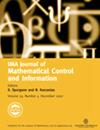HPA axis differential flatness and Liouvillian study for higher resiliency investigations
IF 1.6
4区 计算机科学
Q3 AUTOMATION & CONTROL SYSTEMS
IMA Journal of Mathematical Control and Information
Pub Date : 2023-11-29
DOI:10.1093/imamci/dnad030
引用次数: 0
Abstract
In this paper, we study several existing quantitative models of the hypothalamic–pituitary–adrenal (HPA) axis from a control systems theory viewpoint, that is, we suppose that we can act on the dynamics of the HPA axis throughout some parameters, which are the system inputs. In particular, we will focus on flatness and Liouvillian properties of the considered control systems of the HPA axis. We first study the minimal three-dimensional model of Bangsgaard and Ottesen (2017, Math. Biosci., 287:24–35) and the semi-mechanistic four-dimensional model of Gupta et al. (2007, Theor. Biol. Medical Model., 4(1):8) which are shown to be flat, and then, we consider the more involved and important model proposed in Rao & Androulakis (2019, Sci. Rep., 9(1):11212; 2020, IFAC-PapersOnLine, 53(2):15858–15863), with seven states, for which we prove that for the nominal values of the parameters involved in the model, flatness no longer holds. The more involved model satisfies however a similar but weaker property than flatness: it is a Liouvillian system.HPA轴差分平整度和Liouvillian研究用于高弹性研究
本文从控制系统理论的角度研究了几种现有的下丘脑-垂体-肾上腺(HPA)轴的定量模型,即假设我们可以通过作为系统输入的某些参数来作用于HPA轴的动力学。特别地,我们将关注所考虑的HPA轴控制系统的平面性和Liouvillian性质。我们首先研究了Bangsgaard和Ottesen(2017,数学)的最小三维模型。Biosci。Gupta et al. (2007, theory .)的半机械四维模型。医学杂志。医学模式。, 4(1):8)表明是平坦的,然后,我们考虑Rao &Androulakis (2019, Sci。代表,9 (1):11212;2020,中国机械工程学报,53(2):15858-15863),我们证明了对于模型中涉及的参数的标称值,平坦性不再成立。然而,更复杂的模型满足一个与平面性相似但较弱的性质:它是一个刘维系统。
本文章由计算机程序翻译,如有差异,请以英文原文为准。
求助全文
约1分钟内获得全文
求助全文
来源期刊
CiteScore
3.30
自引率
6.70%
发文量
33
审稿时长
>12 weeks
期刊介绍:
The Journal is to provide an outlet for papers which are original and of high quality in mathematical control theory, systems theory, and applied information sciences. Short papers and mathematical correspondence or technical notes will be welcome, although the primary function of the journal is to publish papers of substantial length and coverage. The emphasis will be upon relevance, originality and clarify of presentation, although timeliness may well be an important feature in acceptable papers. Speculative papers that suggest new avenues for research or potential solutions to unsolved problems of control and information theory will be particularly welcome. Specific application papers will not normally be within the remit of the journal. Applications that illustrate techniques or theories will be acceptable. A prime function of the journal is to encourage the interplay between control and information theory and other mathematical sciences.
All submitted papers will be judged on their merits by at least two referees and a full paper report will be available to the intending authors. Submitted articles will in general be published in an issue within six months of submission. Papers should not have previously published, nor should they be undes consideration for publication in another journal. This Journal takes publication ethics very seriously. If misconduct is found or suspected after the manuscript is published, the journal will investigate the matter and this may result in the article subsequently being retracted.

 求助内容:
求助内容: 应助结果提醒方式:
应助结果提醒方式:


